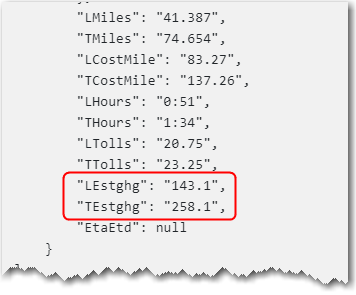Emissions Calculations
Contents
More and more transportation companies are tracking greenhouse gas (GHG) emissions as part of a focus on environmental sustainability. With our Route Reports API, you can calculate the direct carbon dioxide (CO2) emissions generated by a specific vehicle for a specific route.
How are GHG emissions calculated?
Emission calculations take into account the area of the world where the route is being driven. GHG emissions are calculated based on the following standards:
- In North America: GHG calculation is based on emissions factors generated by several sources, including the U.S. Environmental Protection Agency (EPA).
- In Europe: GHG calculation is based on the European Norm EN 16258 standard, which is the most commonly used standard in transportation. We calculate the “Tank-to-Wheel” part of the norm.
In addition to the regional method, the result is calculated using values specific to the route and vehicle. For these vehicle values, the API provides the flexibility to calculate emissions based on:
- Individual values inputted by the user. These values can be specific to a certain type of vehicle or a certain type of fleet, or
- Trimble Maps default values.
What can these calculations be used for?
Shippers might use GHG calculations to estimate and report emissions from transport operations for regulatory filings and customer transparency. Carriers might calculate emissions while quoting and invoicing so shippers can use them for their “indirect” emissions reporting.
How are emissions calculations generated in APIs?
An emissions calculation result is included with the response in Mileage and State reports for every leg of the route and the route in total.

Calculations are based on the specific route (Origin, Destination & Stops) as well as relevant vehicle values, entered using the parameters below. If no values are entered, calculations are based on Trimble Maps default values. These defaults are updated on a regular basis from industry and government data.
In North America
In Route Reports API calls, there are three parameters for GHG calculations:
costGHG- greenhouse gas emissions in pounds or kilograms of carbon dioxide (CO2) per gallon of fuel.fuelEconLoaded- the fuel efficiency (distance units per fuel units) when loaded.fuelEconEmpty- the fuel efficiency (distance units per fuel units) when empty.
With those inputs, GHG emissions = costGHG * (Trip Miles / Fuel Efficiency)
If no values are entered, default values are based on factors generated by several sources, including the U.S. Environmental Protection Agency (EPA).
In Europe
In Europe, there are also three parameters for GHG calculations in Route Reports:
fuelConsumption- the amount of fuel a vehicle consumes in liters per 100 kilometers. If no value is entered, UK Defra 2018 fuel consumption values by vehicle type are used for calculations.refrigerated, which can be set to true or false, based on vehicle type. This setting is only necessary if using Trimble Maps default values. It influences the UK Defra 2018 fuel consumption value as refrigerated trucks typically consume more fuel.fuelType- the type of fuel in the vehicle. Diesel is the default fuel type, and the API offers a number of other options.
With those inputs, GHG emissions = power consumption * Emission factor
- Power consumption is the total fuel used for the trip (in liters). It is calculated from the trip distance in kilometers and fuel consumption value (liter per 100 km).
- The emission factor is a set multiplier based on the fuel type entered.
How can Trimble Maps help lower your carbon emissions?
The Trimble Maps routing engine generates optimal routes, based on the vehicle being driven. Following these routes can help reduce fuel usage and, consequently, your carbon footprint.
Share this article: